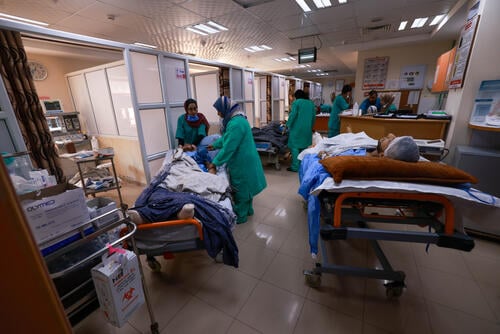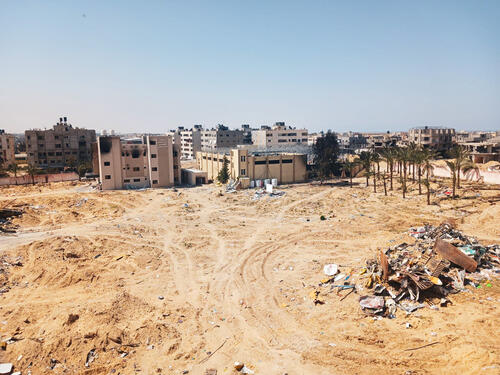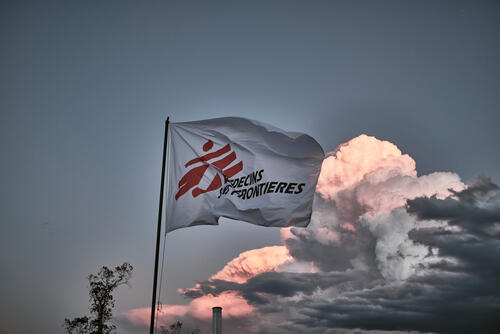Following the outbreak of war in early October between Israel and Hamas in the Gaza Strip, Palestine, Israeli forces have repeatedly pushed people to move from the north of Gaza to the south. Today, the humanitarian situation in the south of Gaza is dire and unsafe. Intense bombardment and fighting have uprooted over 1.8 million people – around 80 per cent of the total population of the Strip. Around one million people are being pushed to relocate into the south, where living conditions were already overcrowded and desperate even prior to the current conflict.
As the truce between Israel and Hamas in Gaza extends into a seventh day, here are five things to know about the current situation in southern Gaza, where teams from Médecins Sans Frontières (MSF) are working.
1. People are living without the essentials
Our teams are reporting seeing people queueing for food and water and cooking gas, while the needs remain uncovered for hundreds of thousands of Palestinians. Despite the entry of several trucks of aid into Gaza, the needs remain hugely unmet. This includes mattresses, warm clothes for winter, blankets and other items.
With the Gaza Strip being disconnected from electrical power by the Israeli forces and fuel reserves depleted, all essential services such as health, water and sanitation, and communication, were forced to shut down one by one. The complete siege imposed by the Israeli government has deprived the entirety of Gaza’s people of essential supplies such as food, water, shelter, and medical care.
2. The few medical facilities that are functioning are overwhelmed
In southern Gaza, only eight out of eleven health facilities are currently functioning (UN OCHA, 26 November). They are currently receiving far more people than they normally do, knowing there is a huge lack of material, resources, water and power. The lack of space is also a problem, because like the north, hospitals in the south have become a refuge for thousands of displaced people.
“The entire health system here in Gaza just does not have the capacity to cope with the current situation,” says Marie-Aure Perreaut, MSF emergency coordinator in Gaza. “Hospitals are completely overwhelmed with the influx of wounded they've been receiving for the past few weeks.”
In Martyrs clinic in Khan Younis, where our teams are working, the number of consultations per day has increased from roughly 250 to roughly 1,000 consultations.
Other hospitals that our teams visited are running out of beds, and patients are lying in the hallways waiting to receive treatment.
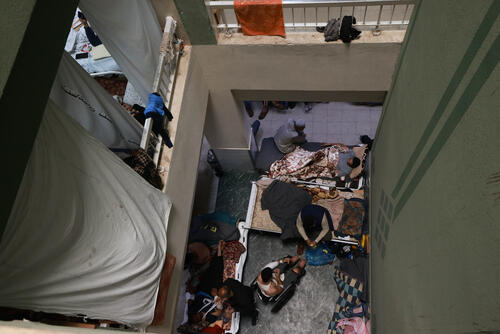
3. The extremely high population density is having – and will have – health consequences
The Gaza Strip is one of the most densely populated areas in the world. Just over 2 million people reside in the Strip, in an area of 365km2 – or equivalent to about half the size of New York City. The forced displacement of almost the entire population of Gaza to a smaller, delimited space in the south, has pushed the density even higher. One million people are crammed into a relatively small area; they can’t move and are entirely dependent on humanitarian aid. The terrible living conditions are putting people’s health at risk.
“We're seeing an increasing number of children and women with domestic injuries, mostly from burns and other conditions,” says Marie-Aure. “These injuries clearly illustrate the extremely precarious living conditions and the overcrowding of the shelters and the camps.”
A density of population as high as is the case is now in the south is a risk in terms of communicable diseases. People living in crowded spaces, with a lack of water and sanitation, and no prevention and surveillance system, is a recipe for disaster for diseases like cholera and measles.
“Today we received a case that is linked to complications of chronic diseases, infections, viruses and bacteria that many people have, due to the overcrowded living conditions in shelters like centres and schools,” says Jameel Awad Allah, an MSF nurse at Martyrs Clinic.
4. There are overwhelming needs for war wound and mental health care
In Martyrs clinic, our teams provide outpatient consultations to children and adults, as well as wound dressings, mostly from blasts and infected wounds. Our teams are also doing triage and referrals of trauma cases to Nasser hospital.
Those hospitals that are still operational are overflowing with war-wounded patients.
“Most of the cases that we receive here are because of the war, from shrapnel or fractures,” says Awad Allah in Martyrs Clinic. “We also have burns cases.”
On top of the need for surgical, burn and wound care from the bombing and the shelling, our teams are observing basic healthcare needs, such as maternity, general medicine and especially for mental health. In Khan Younis, we offer mental health sessions for children and women.
“We are providing mental health support to all people who are here, especially the internally displaced,” says Marwa Abu Al Nour, an MSF psychologist. “The most common things I see among children are nightmares, bed-wetting, anxiety, and fear. We try as much as possible to give them support via recreational activities.”
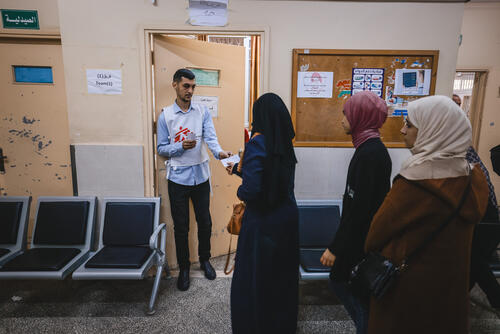
5. MSF teams are responding across southern Gaza
Today, MSF is working in two hospitals in southern Gaza – Nasser and Al-Aqsa hospitals – and in two clinics in Khan Younis, Martyrs and Beni Suhaila clinics.
In Nasser Hospital, we provide emergency care and surgical treatment, including to patients with traumatic injuries and severe burn injuries. We also support the Emergency Department and ICU.
In Al Aqsa hospital, in the Middle Area, we started activities in support of the hospital’s staff. We are working on wound dressings and outpatient consultations for patients with blast injuries and burns.
In Martyrs clinic, we provide outpatient and mental health consultations and offer basic health care, such as dressing wounds, at Beni Suhaila clinic.



